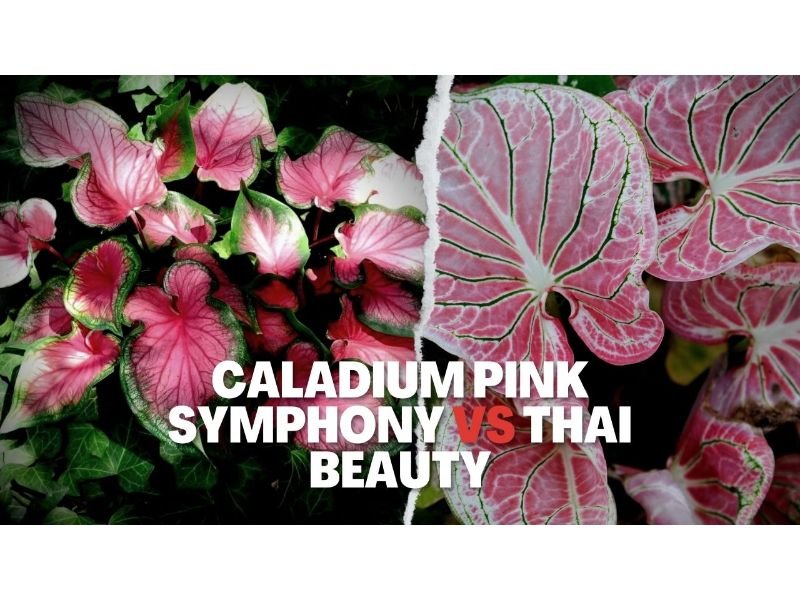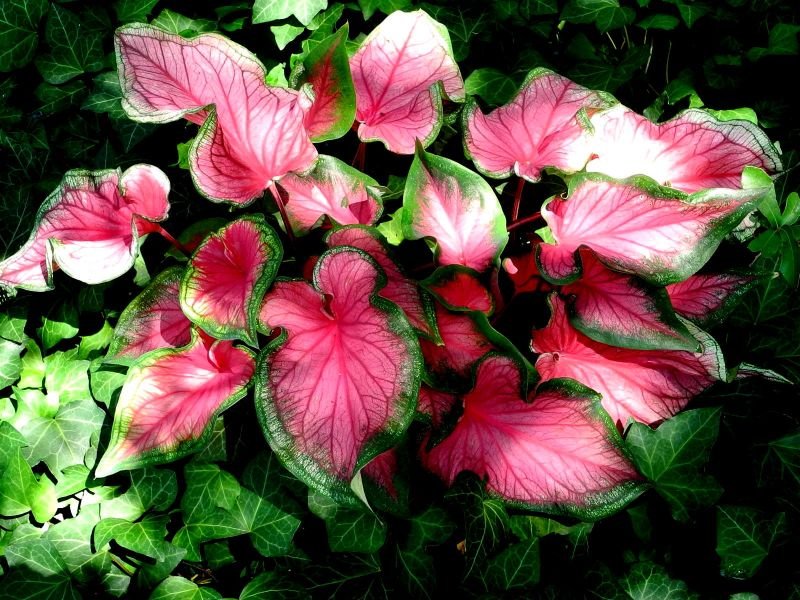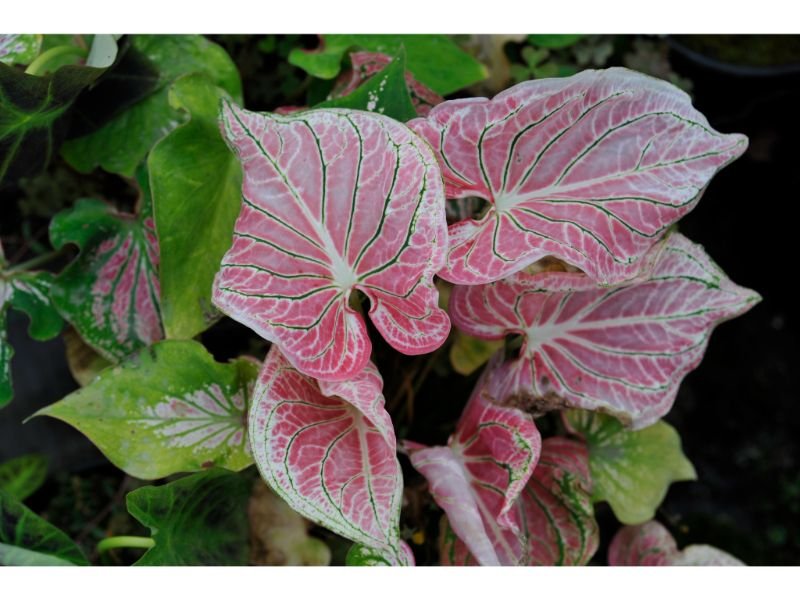When it comes to ornamental foliage plants, few can match the stunning beauty of caladiums. Two of the most popular caladium varieties, Caladium Pink Symphony and Caladium Thai Beauty, are among the most captivating with their distinctive charm and allure. While both varieties share similarities that most of the time can be hard to set them apart, Caladium Pink Symphony vs Thai Beauty are two different plants with unique appeals. Without further ado, let’s get to know them!

Table of Contents
Growing Zones
Caladium Pink Symphony vs Thai Beauty shares the same growing zones. These gorgeous aroids can be grown as annuals or perennials from zones 9 through 11. Relatively warm zones with mild winters, zones 9 through 11 are flawless for Pink Symphony and Thai Beauty as they’re not a fan of winter. Although originated from the same parent plants that are native to Central and Southern America, Thai Beauty, which is a hybrid, was cultivated in Thailand.
Plant Size
Both Pink Symphony and Thai Beauty are compact cultivars. Pink Symphony sizing to only about 20 to 24 inches (50 to 60 centimeters) in height and width, while Thai Beauty, a much smaller plant, only thrives to approximately 11 to 15 inches (30 to 40 centimeters) tall and wide. Despite their tiny size, Pink Symphony and Thai Beauty are highly desirable and considered rare caladiums.
Color and Appearance
Let’s face it, one of the easiest ways to differentiate plants is through their color, isn’t it? While Caladium Pink Symphony vs Thai Beauty may seem like the same cultivars at first, there’s one key point to help plant enthusiasts distinguish these two.

Generally, Pink Symphony features ruffled heart-shaped thin foliage with a pale, whitish-pink complexion. This plant has dark green veins that extend to the leaf’s margin. The veining dark green part of Pink Symphony is less prominent than Thai Beauty.

Thai Beauty is treasured not only for their pink color. Featuring ruffled heart-shaped foliage that is more roundish, the leaves of Thai Beauty can be a mix of pale pink, milky white, dark green, or even magenta. The dark green veins of this plant, which also stretch out to the edges, are far more prominent than the ones in Pink Symphony. Both plants are coming with thin, dark, slightly reddish-brown stems.
Fruits and Flowers
The small, arum-like blooms and berry-like fruits are not the main features of Pink Symphony and Thai Beauty. While they do rarely produce blooms and fruits, these parts are mainly not showy and are often removed to encourage more foliage growth.
Growing Season
Caladium Pink Symphony vs Thai Beauty have similar growing seasons due to their shared warm tropical origins, where they mostly grow from the start of early spring and peaking during summer.
To provide months of spectacular foliage throughout the growing season, Thai Beauty and Pink Symphony requires proper care and attention that is overall easy even for novice gardeners. We’ll discuss this more in the following section.
Caladium Pink Symphony vs Thai Beauty: Basic Care Guide
Light
Providing the right light is predominant for plants’ growth, and regarding Caladium Thai Beauty vs Pink Symphony, there are no much different light requirements! These plants prefer bright, indirect sunlight or partial shade.
While Pink Symphony and Thai Beauty benefit from two to six hours of daily direct sunlight, being exposed too much to areas with direct and intense light can do more harm than good.
Watering
Indoors or outdoors, Pink Symphony and Thai Beauty require consistent moisture to thrive, but it’s worth noting to never overwater them. The best time to give them water is by doing the soil checking by dipping your fingers into a few inches of the topsoil. If it feels dry and there’s no soil sticking out to your fingers, it means time for watering!
Normally, Pink Symphony and Thai Beauty need to be watered about once to twice a week. Allow all the excess water to fully drain out first between each watering schedule.
Soil
Another similar growing condition that Caladium Pink Symphony vs Thai Beauty shares is the soil requirements. A well-draining, slightly acidic loamy or sandy soil that contains high organic matter is what the Pink Symphony and Thai Beauty favor the most.
Pick the best soil mix that is formulated especially for aroids with a soil pH range between 5.5 to 6.5. Make sure the growing space has enough drainage holes, which is also paramount to prevent the water from being clogged.
Temperature and Humidity
Both Pink Symphony and Thai Beauty are tropical plants that thrive in warm and humid environments. They prefer temperatures between 70°F to 85°F (21°C to 29°C) and can tolerate cold temperatures as low as 60°F (15°C). Avoid too cold temperatures as this can lead to the plant’s dormancy.
Set the humidity level ideally between 60% to 80%. To increase humidity, Pink Symphony and Thai Beauty love a regular misting schedule. You can also place the plant near a humidifier or tray of water.
Pruning and Propagating
As with any other plants, Caladium Pink Symphony vs Thai Beauty benefits from pruning to help maintain their shape and encourage new growth. The best pruning schedule for these plants is right before or during their growing season. Simply remove any dead or damaged foliage with sterilized and clean gardening shears.
Propagating Thai Beauty and Pink Symphony is just as easy as pruning them. These two can be propagated through tuber division. Remove the plant from its pot and carefully separate the tubers by hand. Make sure that each tuber has a healthy root system with tiny sprouts. Replant each tuber in its new pots or containers and take care of them as usual. Propagation is best done during spring.
Pests and Diseases
The good news is, Pink Symphony and Thai Beauty are not prone to serious pests and diseases, however, they’re still prone to common houseplant pests such as aphids, mealy bugs, spider mites, and common diseases like root rot, stunted or leggy growth, and yellowing or burning leaves.
To prevent these problems, it’s important to keep in mind to always provide the best growing environment for the plants and improve air circulation. Pests can be cured by using insecticide, neem oil, or pesticide and by maintaining good hygiene.
Winter Care
As mentioned earlier, Thai Beauty and Pink Symphony are not fond of winter and frost. During winter months, it’s highly recommended to bring them indoors or treat them as annuals and replant them at the next growing season.
The plants may go dormant and lose some of their delicate foliage, which is normal and doesn’t always mean the plant’s death. To grow indoors during winter, make sure to acclimate the light, humidity levels, and temperatures.
Caladium Thai Beauty vs Pink Symphony: Which One Is More Poisonous?
Even though blessed with breathtaking visuals, Pink Symphony and Thai Beauty are equally poisonous and contain water-insoluble calcium oxalate crystals. This chemical compound can be toxic for humans and pets, especially if large quantities are eaten. Symptoms include a burning sensation in the mouth, vomiting, and digestive-related problems. Therefore, it’s important to keep these plants away from children and pets and to seek medical attention immediately if an accident happens.
How Fast Do Caladium Pink Symphony and Thai Beauty Grow?
There’s no exact answer when it comes to the growing rate between Caladium Pink Symphony vs Thai Beauty, as it depends on numerous factors such as light, soil, temperatures, and outside stressors. Nonetheless, Pink Symphony and Thai Beauty are considered moderate to slow-growing houseplants.
Do Caladium Pink Symphony and Thai Beauty Have Fragrances?
No, Thai Beauty and Pink Symphony do not have any particular fragrance other than the earthy smell, which is common for most plants.
Caladium Pink Symphony vs Thai Beauty: Similar But Not Exactly the Same
To ring down the curtain, Thai Beauty and Pink Symphony are caladium cultivars that produce heart-shaped foliage with different shapes and colors. Pink Symphony is generally more elongated with a bigger size, whereas Thai Beauty is roundish with a more compact size. Nevertheless, these two share a similar maintenance routine that can be easy to do if you’re planning to grow them both.

New author in the hood. Loves gardening and flowers are my spirit animals (yes I know they are not animals but I insist). I will be covering most of the flowers’ topics here and occasionally random though as well.






